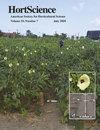昆虫病原真菌类杀虫剂和昆虫生长调节剂混合物对温室条件下的柑橘粉蚧、柑橘平球菌(半翅目:假球虫科)、以花椰菜为食的植物、黄芩属植物有效吗?
IF 1.6
3区 农林科学
Q2 HORTICULTURE
引用次数: 0
摘要
柑橘粉蚧(Planococcus citri)是温室园艺作物的害虫。柑橘粉蚧以植物的叶、茎、花和果实为食,对植物造成损害,造成巨大的经济损失。杀虫剂用于管理温室生产系统中的柑橘粉蚧种群。轶事信息表明,混合昆虫病原真菌杀虫剂与昆虫生长调节剂可能有效地管理温室条件下的柑橘粉蚧种群。因此,我们于2023年在堪萨斯州立大学(Manhattan, KS, USA)的一个研究温室中进行了两个实验。本实验旨在测定3种市售的虫病真菌类杀虫剂(白僵菌菌株GHA (BotaniGard®)、白僵菌菌株PPRI 5339 (Velifer™)和Isaria fumosorosea Apopka菌株97 (Ancora®))与3种昆虫生长调节剂(印扎七素(Azatin®O)、新伐菌素(Pedestal®)和吡虫腈(Distance®))混合后对以桔梗植物为食的柑橘粉虱的效果。单独使用昆虫病原真菌类杀虫剂或与昆虫生长调节剂混合使用均不能有效控制柑橘粉蚧种群,每次试验死亡率为20%。此外,所有用昆虫病原真菌类杀虫剂处理过的彩色植物叶片上都有白色粉末状残留物。我们的研究表明,昆虫病原真菌类杀虫剂,即使与昆虫生长调节剂混合使用,也不能有效地控制温室中的柑橘粉蚧种群,这可能是因为环境条件(温度和相对湿度)不适合孢子萌发和菌丝感染的发生。因此,以昆虫病原真菌为基础的杀虫剂在温室生产系统中管理害虫的用途有限。本文章由计算机程序翻译,如有差异,请以英文原文为准。
Are Entomopathogenic Fungal-based Insecticides and Insect Growth Regulator Mixtures Effective Against the Citrus Mealybug, Planococcus citri (Hemiptera: Pseudococcidae), Feeding on Coleus, Solenostemon scutellarioides, Plants under Greenhouse Conditions?
The citrus mealybug, Planococcus citri , is an insect pest of greenhouse-grown horticultural crops. Citrus mealybug causes plant damage when feeding on plant leaves, stems, flowers, and fruits, resulting in a substantial economic loss. Insecticides are applied to manage citrus mealybug populations in greenhouse production systems. Anecdotal information suggests that mixing entomopathogenic fungal-based insecticides with insect growth regulators may be effective for managing citrus mealybug populations under greenhouse conditions. Consequently, we conducted two experiments in a research greenhouse at Kansas State University (Manhattan, KS, USA) in 2023. The experiments were designed to determine the efficacy of three commercially available entomopathogenic fungal-based insecticides [ Beauveria bassiana Strain GHA (BotaniGard ® ), B. bassiana strain PPRI 5339 (Velifer™) and Isaria fumosorosea Apopka Strain 97 (Ancora ® )] when mixed with three insect growth regulators [azadirachtin (Azatin ® O), novaluron (Pedestal ® ), and pyriproxyfen (Distance ® )] on citrus mealybug feeding on coleus, Solenostemon scutellarioides , plants. The entomopathogenic fungal-based insecticides alone or when mixed with the insect growth regulators were not effective in managing citrus mealybug populations, with <20% mortality during each experiment. In addition, all coleus plants treated with the entomopathogenic fungal-based insecticides had a white, powdery residue on the leaves. Our study demonstrates that entomopathogenic fungal-based insecticides, even when mixed with insect growth regulators, are not effective in managing citrus mealybug populations in greenhouses, which is likely because the environmental conditions (temperature and relative humidity) are not optimal for conidial germination and hyphal infection to occur. Therefore, entomopathogenic fungal-based insecticides have limited use for managing insect pests in greenhouse production systems.
求助全文
通过发布文献求助,成功后即可免费获取论文全文。
去求助
来源期刊

Hortscience
农林科学-园艺
CiteScore
3.00
自引率
10.50%
发文量
224
审稿时长
3 months
期刊介绍:
HortScience publishes horticultural information of interest to a broad array of horticulturists. Its goals are to apprise horticultural scientists and others interested in horticulture of scientific and industry developments and of significant research, education, or extension findings or methods.
 求助内容:
求助内容: 应助结果提醒方式:
应助结果提醒方式:


